#custom software deployment
Explore tagged Tumblr posts
Text
Odoo ERP Implementation Costs for U.S. Manufacturing Companies: A Comprehensive Guide
Implementing an Enterprise Resource Planning (ERP) system like Odoo ERP implementation cost can revolutionize operations for manufacturing companies. However, understanding the associated costs is crucial for budgeting and decision-making. This guide delves into the average expenses involved in deploying Odoo ERP within U.S. manufacturing firms. Understanding Odoo ERP Odoo offers a suite of…
#business software costs#ERP customization#ERP implementation cost#ERP solutions U.S.#manufacturing ERP#manufacturing software#Odoo deployment#Odoo ERP#Odoo licensing#Odoo pricing
0 notes
Text
The Role of DevOps in Custom Software Deployment

In today’s fast-paced digital ecosystem, the success of any software product is determined not just by how well it's coded, but how efficiently and reliably it’s delivered to end-users. This is where DevOps—the fusion of development and operations—plays a transformative role.
For businesses working with a custom software development company in New York, DevOps is no longer an optional methodology—it’s a competitive necessity. From speeding up deployment cycles to improving reliability, security, and scalability, DevOps practices streamline the entire software delivery pipeline.
In this blog, we’ll explore the critical role of DevOps in custom software deployment, the advantages it offers, and how software development companies in New York are leveraging DevOps to deliver faster, smarter, and more resilient digital solutions.
What Is DevOps?
DevOps is a set of practices and tools that bridge the gap between software development (Dev) and IT operations (Ops). Its primary goal is to shorten the development lifecycle, increase deployment frequency, and deliver high-quality software in a repeatable and automated way.
This is accomplished through key principles such as:
Continuous Integration (CI)
Continuous Delivery/Deployment (CD)
Infrastructure as Code (IaC)
Automated testing
Monitoring and logging
The best custom software development companies in New York integrate these practices into their workflows to reduce downtime, prevent deployment bottlenecks, and foster innovation.
DevOps in Custom Software: Why It Matters
Unlike off-the-shelf software, custom solutions are tailor-made for specific business needs. They require greater agility, flexibility, and ongoing refinement—all of which are supported by a robust DevOps approach.
Here’s why DevOps is especially vital in custom software projects:
1. Faster Time-to-Market
Speed is crucial in today’s competitive digital space. DevOps enables rapid iterations, automated testing, and continuous deployments—ensuring that new features and bug fixes go live faster.
For example, a software development company in New York using DevOps can deliver weekly or even daily updates, significantly reducing the time it takes to respond to user feedback or market demands.
2. Higher Quality Code
Automated testing and code integration tools allow developers to catch bugs early in the development cycle. This leads to fewer production issues and better software quality overall.
The top software development companies in New York use automated quality gates, unit tests, and peer code reviews integrated into the CI/CD pipeline, ensuring every code release meets strict standards.
3. Scalability and Flexibility
As businesses grow, their software needs to scale accordingly. DevOps supports scalability through containerization (like Docker), orchestration tools (like Kubernetes), and cloud-native deployment models.
Working with a custom software development company in New York that understands cloud and DevOps architecture means your software can grow seamlessly with your business needs.
Key DevOps Practices That Support Deployment
To understand the true value of DevOps in deployment, it’s important to dive deeper into the specific practices that make it effective.
1. Continuous Integration (CI)
CI involves automatically merging all developer working copies to a shared mainline several times a day. This enables early bug detection, reduced integration issues, and a smoother development workflow.
Custom software development companies in New York often integrate tools like Jenkins, GitLab CI, or CircleCI to automate builds and ensure code is always in a deployable state.
2. Continuous Deployment (CD)
Continuous Deployment automates the release process so that any code passing all tests is immediately deployed to production. This creates a cycle of fast and reliable releases.
This is particularly useful for industries like fintech or e-commerce, where downtime or bugs can result in serious revenue loss. A software development company in New York using CD can deploy features safely and frequently without compromising performance.
3. Infrastructure as Code (IaC)
IaC allows infrastructure (like servers, load balancers, and databases) to be managed through code, making environments consistent and reproducible. Tools like Terraform and Ansible are widely used.
The best software development company in New York will use IaC to reduce human error, enable version control of infrastructure, and simplify environment replication across dev, test, and production.
4. Monitoring and Feedback Loops
DevOps emphasizes continuous monitoring of application performance and infrastructure health using tools like Prometheus, Grafana, and ELK Stack.
With these insights, custom software development companies in New York can proactively identify issues, analyze usage trends, and optimize applications to improve user experience.
DevOps for Custom Software Clients: What to Expect
When working with a DevOps-enabled software development company in New York, clients can expect the following:
1. Transparent Release Processes
Frequent, scheduled releases replace traditional “big-bang” launches. You’re always aware of what’s being deployed and when, with detailed changelogs and documentation.
2. Reduced Downtime
Through canary releases, blue-green deployments, and automated rollback mechanisms, DevOps minimizes the risk of outages during updates.
3. More Reliable Support
DevOps fosters a culture of accountability. Developers monitor how their code performs in production and fix issues promptly—ensuring a more stable product lifecycle.
4. Custom Dashboards and Metrics
Get real-time visibility into your application’s health, user engagement, and server performance with custom dashboards tailored to your KPIs.
The top software development company in New York will customize these tools for your business model, giving you actionable insights at a glance.
Why DevOps Is a Competitive Edge
In industries like finance, healthcare, retail, and logistics, speed and stability aren’t just nice-to-haves—they're vital. DevOps offers:
Accelerated innovation: Quickly test and implement new ideas.
Enhanced security: Apply security policies and patches faster.
Customer satisfaction: Deliver bug-free features continuously.
Operational efficiency: Automate repetitive tasks to focus on high-value work.
For companies looking to stand out, partnering with a custom software development company in New York that champions DevOps is an investment in agility and excellence.
Choosing the Right DevOps-Enabled Software Partner
Not every software firm embraces DevOps, and not every team does it well. Here’s what to look for:
DevOps toolchain expertise (Git, Jenkins, Docker, Kubernetes)
Experience with cloud platforms (AWS, Azure, Google Cloud)
Track record of CI/CD pipelines
Commitment to security and compliance
24/7 monitoring and support
The best software development company in New York will have proven case studies, client testimonials, and a clear DevOps roadmap that aligns with your vision.
Final Thoughts
DevOps has redefined the way custom software is developed, deployed, and maintained. It promotes agility, reliability, and collaboration—three pillars essential for long-term software success.
In a city as competitive and innovation-driven as New York, choosing the right partner is crucial. Whether you’re a startup disrupting your industry or an enterprise modernizing legacy systems, working with a custom software development company in New York that fully embraces DevOps can give you a decisive edge.
If you want continuous improvement, faster delivery cycles, and robust deployment processes, look no further than the top software development company in New York. They don’t just build software—they deliver future-ready solutions that evolve with your business.
#custom software development company in new york#software development company in new york#custom software development companies in new york#top software development company in new york#best software development company in new york#The Role of DevOps in Custom Software Deployment
0 notes
Text
Software Development Company in Patna - Cybonetic Technologies Pvt Ltd
Cybonetic Technologies Pvt Ltd is an innovative software development company in Patna. We are dedicated to helping businesses with modern software solutions to grow and run business smoothly. Our expert software developer team specializes in a wide range of services, including mobile app development, website development, E-commerce development, and software consulting, delivering top-quality services for your business needs. We also focus on creating user-friendly, scalable, and robust software that empowers your business operations. Contact us today!
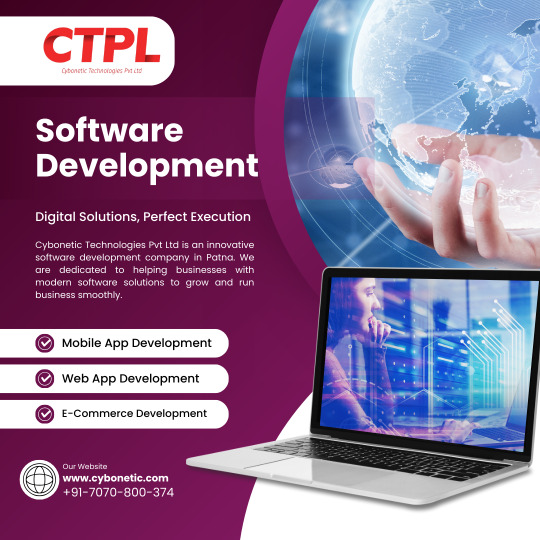
#software development#software development company in Patna#custom software applications#software developers#software development tools#programming languages#end-to-end solutions#testing#deployment#maintenance#innovative software solutions
0 notes
Text
Platform Engineering: Streamlining Modern Software Development
New Post has been published on https://thedigitalinsider.com/platform-engineering-streamlining-modern-software-development/
Platform Engineering: Streamlining Modern Software Development
As we accelerate ahead of Industry 4.0, digital transformation reshapes businesses at an unprecedented level. Today, organizations face high pressures to deliver software faster, more reliably, and at scale.
The growing complexities of the cloud environment and heightened demand for frictionless customer experiences have further complicated software development. Since delivering a seamless customer experience is an organization’s top priority, continuous software development runs parallel with other operations.
Platform engineering has emerged to address these challenges. It is based upon integrating product names as an internal developer’s platform designed to streamline the software development process.
According to a research by Gartner, “45% of large software engineering organizations were already utilizing platform engineering platforms in 2022, and the number is expected to rise by 80% by 2026.”.
This article will explain platform engineering and its benefits and see how it boosts the entire software development cycle.
What is Platform Engineering?
With ever-increasing functionalities, cloud environments are becoming more complex every day. Developing new tools and software isn’t easy now. Sometimes, software development-related complexities, the underlying infrastructure that must be managed, and routine tasks become hard to tackle.
Platform engineering focuses on designing, developing, and optimizing Internal Developers Platforms (IDPs).
IDPs work as an added layer and bridge the gap between developers and underlying infrastructure. Adopting an IDP enables workflow standardizations, self-services in software development, and improved observability in development.
With all these workflow enhancements, developers can work in more automated environments. By enabling automation at every level, the internal data platforms streamline the software development lifecycle (SDCL) while adhering to the governance and compliance standards.
Core Concepts of Platform Engineering
As cloud computing, microservices, and containerization grew, organizations opted for more advanced platforms to manage their complexities. An engineering platform in software development creates a cohesive and efficient development environment that enhances productivity while maintaining operational stability.
Here are some of the core concepts of platform engineering:
1. Internal Developer Platform (IDP)
Internal Developer Platforms (IDPs) are designed to help organizations optimize their development processes. As development processes become more iterative, cloud complexities become an added burden.
Source
IDPs act as added layers in the development process, simplifying operations and enabling teams to leverage existing development technologies. It is an ecosystem that empowers developers by providing tools and automation and autonomously managing the end-to-end lifecycle, from development to deployment.
Some of the most demanded IDPs are:
Qovery
Platform.sh
Backstage by Spotify
Humanitec
Coherence
However, if not implemented strategically, IDPs can introduce further complexities downstream.
2. Self-Service
One of platform engineering’s most powerful features is its capability to empower developers through self-service. This means developers can work independently, provision, manage, and deploy applications without relying on operations teams. It empowers the workflow, enabling developers to iterate and deploy efficiently.
3. Workflow Automation
Automation is another reason to adopt an engineering platform. It automates routine tasks and reduces human error while ensuring scalability and consistency across the development lifecycle.
4. Standardization
Engineering platforms promote end-to-end standardization of best practices across the development workflow. They usually have built-in quality standards to meet compliance requirements. So, both organizations and development teams automatically follow compliance best practices.
5. Security & Governance
As security and governance are core concerns in any SDLC, integrating a robust engineering platform ensures robust governance to minimize vulnerabilities and risks.
6. Infrastructure as Code (IaC)
Platform engineering enables development teams to provision and manage infrastructure resources in repeatable and automated ways. It also promotes version control for easier management and collaboration and faster time-to-market.
At its core, it manages the development process more efficiently by reducing development complexities and ensuring compliance and quality.
Why is Platform Engineering Important to Adapt?
Platform engineering has gained importance due to the growing complexity of software and cloud-based development environments. Managing multiple development environments, multifaceted cloud environments, and diverse technology loads obstructs developers.
To avoid this, internal development platforms streamline the process by creating scalable, reusable platforms to automate tasks and simplify processes.
An IDP allows developers to stay ahead and be more productive at high-value tasks rather than tackling underlying infrastructure. Moreover, platform engineering enables security measures in the development process, diminishing risks and ensuring compliance.
Benefits of Platform Engineering
Internal development platforms offer several critical benefits that boost the overall software development process.
Accelerates Development Process: The cross-functional and automated collaborative environment leads to faster time-to-market and rationalized development costs.
Improves Developer Experience: Platform engineering offers self-service capabilities, enabling developers to be efficient and creative and focus on innovation instead of infrastructural complexities.
Enhances Scalability: Engineering platforms empower organizations to scale their applications and infrastructure to meet growing demands.
Establishes Governance: Platform engineering promotes governance, which is critical for all industries. It ensures that all activities are compliant and aligned with best practices.
Is Platform Engineering the Future of Software Development?
As businesses transform digitally, platform engineering provides a unified infrastructure to empower the build, test, and deployment processes. Integrating artificial intelligence (AI) will lead to more efficient internal platform services in the future.
Moreover, early adoption will provide a competitive advantage for seamless software development workflows.
For more resources on software development, cloud computing, and AI, visit Unite.ai.
#2022#adoption#ai#AI in software development#amp#applications#Article#artificial#Artificial Intelligence#automation#bridge#Cloud#cloud computing#cloud environment#code#Collaboration#collaborative#complexity#compliance#computing#containerization#continuous#customer experience#customer experiences#data#deployment#Developer#developers#development#development environment
0 notes
Text
Logitech Unveils Signature Slim Keyboard Combo to Seamlessly Flow Between Work and Life at the Desk
SYDNEY, Australia. – March 27, 2024 – Today Logitech (SIX: LOGN) (NASDAQ: LOGI) introduced the Signature Slim Combo, designed to simplify the experience across personal and work computers. For people with a single workspace for both professional and personal tasks, the Signature Slim products are beautifully designed solutions that look good in the home or office. With more features than typical…

View On WordPress
#Business#carbon neutral#Compatibility#customization#Deployment#environmental#FSC#IT#Keyboard#Logitech#March 2024#monitoring#Mouse#Office#Personal#Price#Quiet Keys#Recycled#Retail#Signature Slim#Silent Clicks#SmartWheel#Software#Support#sustainability#Wireless#Workspace
0 notes
Text
Developers and admins in Salesforce should constantly be on the lookout for effective deployment tools for answering questions, resolving bugs, and keeping the production organs in the best possible condition. However, there are times when developers might encounter a stumbling block in the event of testing the changes they have made to the Salesforce sandbox before deployments are made to the production environment.
Planning to hire Salesforce Development Company? Connect Now
#devops process#salesforce deployment#salesforce deployment tools#software development#custom software development#asp.net development#.net development
0 notes
Text
Discover the benefits of a multi-cloud strategy for organizations and learn how to enhance security through automation in a multicloud environment.
#Multiple Cloud Computing Services#Multi-Cloud Strategy#Multiple Cloud Providers#Cloud Service Providers#Hybrid Cloud Deployments#Multi-Cloud Security Strategy#Software Product Design And Development Solutions Company#Custom Software Product Engineering Services Company
0 notes
Text
Explore why organizations opt for multi-cloud strategies and gain practical insights on implementing automated security measures.
#Multiple Cloud Computing Services#Multi-Cloud Strategy#Multiple Cloud Providers#Cloud Service Providers#Hybrid Cloud Deployments#Multi-Cloud Security Strategy#Software Product Design And Development Solutions Company#Custom Software Product Engineering Services Company
0 notes
Text
Learn why organizations embrace multi-cloud approaches and discover effective ways to automate security across multiple cloud platforms.
#Multiple Cloud Computing Services#Multi-Cloud Strategy#Multiple Cloud Providers#Cloud Service Providers#Hybrid Cloud Deployments#Multi-Cloud Security Strategy#Software Product Design And Development Solutions Company#Custom Software Product Engineering Services Company
0 notes
Text
Learn why organizations embrace multi-cloud approaches and discover effective ways to automate security across multiple cloud platforms.
#Multiple Cloud Computing Services#Multi-Cloud Strategy#Multiple Cloud Providers#Cloud Service Providers#Hybrid Cloud Deployments#Multi-Cloud Security Strategy#Software Product Design And Development Solutions Company#Custom Software Product Engineering Services Company
0 notes
Text
Learn why organizations embrace multi-cloud approaches and discover effective ways to automate security across multiple cloud platforms.
#Multiple Cloud Computing Services#Multi-Cloud Strategy#Multiple Cloud Providers#Cloud Service Providers#Hybrid Cloud Deployments#Multi-Cloud Security Strategy#Software Product Design And Development Solutions Company#Custom Software Product Engineering Services Company
0 notes
Text
The MS-07B Gouf
In preparation for the invasion of Earth, Zeon forces modified a number of MS-06 Zaku-II F-types for use under the effects of the planet's gravity. The new "J-type" Zaku-IIs featured a number of internal hardware and software changes to enhance their viability on the ground.
The Zaku-II J-Type would be used as a testbed for new developments with the goal of creating a new mass-production mobile suit for use on the ground. And where the Zaku was intended for anti-ship and anti-aerospace combat, this new platform would be built to fight other mobile suits.
Zimmad and Zeonic would both begin working on this new project, directly competing with one another, but eventually coming up with very similar designs. Zeonic moved forward with the YMS-07A Prototype Gouf, and Zimmad presented the YMS-08A High Mobility Test Type.


While Zimmad's design failed to show a significant increase in performance from the Zaku-II J-Type, Zeonic's "Gouf" showed immense promise. The prototype would be picked up and would see a limited production run as the MS-07A Gouf.

The MS-07A was a pre-production model intended for data gathering. The final mass-production model would feature several additional weapon systems, such as an in-built 75mm machine gun in the left manipulator, and a retractable "Heat Rod" on the left forearm.


The Gouf was used to great effect by Zeon captain Ramba Ral, who went toe-to-toe with the Earth Federation's infamous RX-78-2 Gundam.

Among the Ace pilots who used the Gouf as their personal units, Viche Donahue, Silas Locke, and Norris Packard were among the most well-known. All three of these aces would become battlefield legends, with Packard's MS-07B-3 Gouf Custom becoming especially infamous. The machine's equipment proved so effective that it became a common alternate loadout for many Gouf pilots.



The MS-07 would be customized for a variety of roles and theaters, with many of these variants seeing further developments of their own.



Notable among these was the MS-07W Gouf Combined Test Type, which featured a miniaturized Dopp fighter serving as its cockpit. The development of the machine was heavily influenced by data gathered from the Federation's RX-series of mobile suits. Namely, their "Core Block" system.


The Gouf would also see another fork, being developed into the MS-07H Gouf Flight Type. While both prototypes made use of thermonuclear rocket engines, the final version used thermonuclear jet engines, allowing for greater efficiency in atmospheric flight.



The MS-07B saw further refinement into the MS-07C. While not much is known about its specifications, there are at least three known variants. A number of Goufs were acquired by Zimmad and used as testbeds for systems to be incorporated into the MS-09 Dom series of mobile suits. These Goufs were MS-07Cs.



And finally, in UC 120, nearly 50 years from the initial deployment of the original machine, Mars Zeon would develop and deploy the OMS-07RF RF Gouf. While externally resembling the MS-07B, the OMS-07-RF was a completely new machine which could also operate in space, unlike its predecessors.

The MS-07B Gouf was originally designed by Kunio Okawara for the 1979 Anime "Mobile Suit Gundam".
This article was a request! Requests are always welcome!
I am so terribly sorry for the delay in getting this post out! It's been a very hectic few months, but I'm hoping to get back in the flow of things!
23 notes
·
View notes
Text
Patna's Finest Software Development Company - Cybonetic Technologies Pvt Ltd
Explore a transformative experience with Cybonetic Technologies Pvt Ltd, renowned as the top software development company in Patna. Our devoted team is dedicated to delivering state-of-the-art solutions, encompassing Mobile App Development, Website Development, E-Commerce Development, software consulting, and Digital Marketing Services. Witness business expansion with our inventive and budget-friendly offerings. Contact us to collaboratively shape the future!
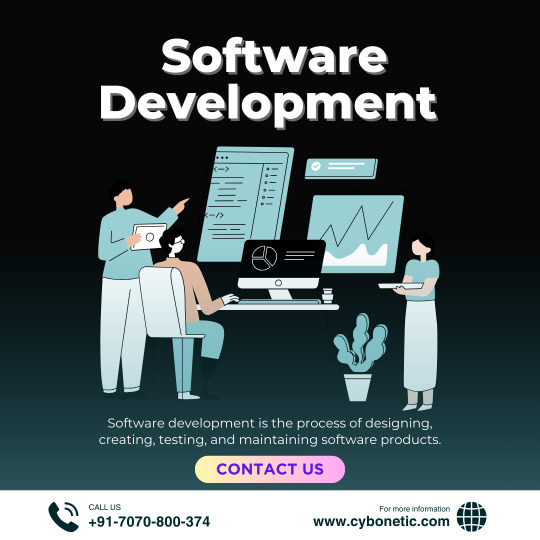
#software development#software development company in Patna#custom software applications#software developers#software development tools#programming languages#end-to-end solutions#testing#deployment#maintenance#innovative software solutions
0 notes
Text
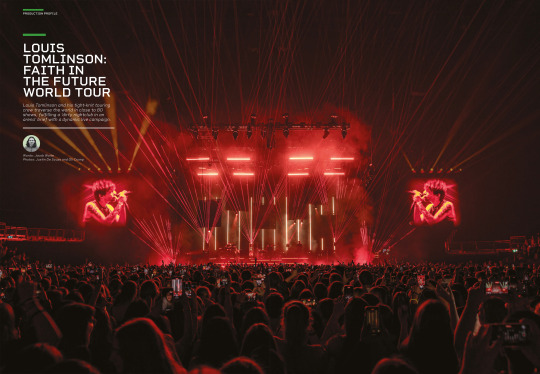
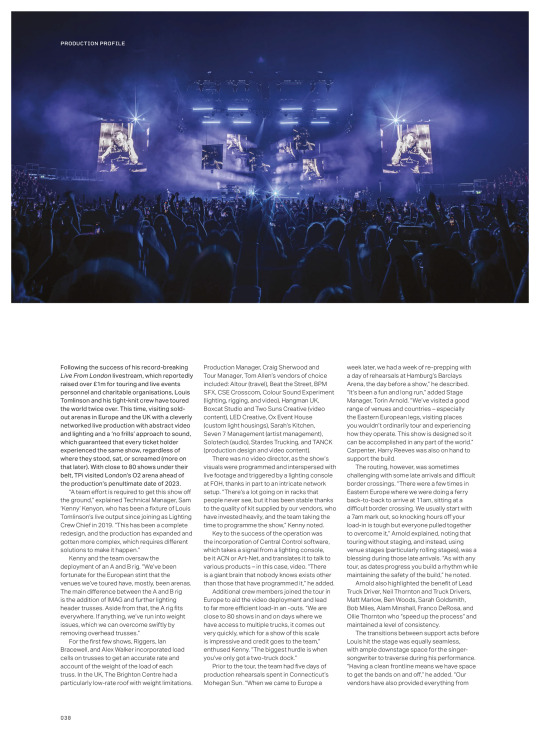
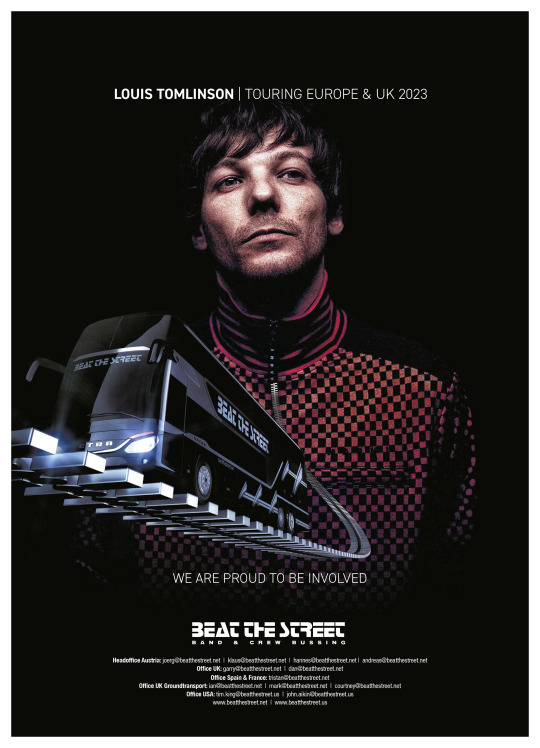
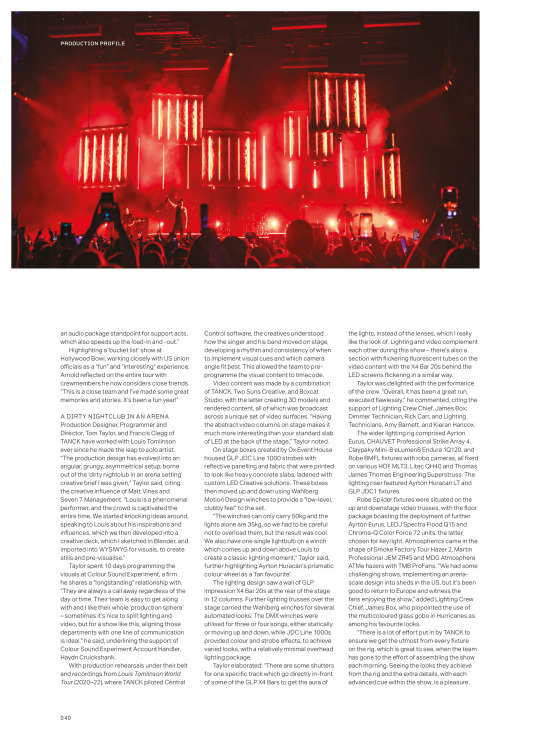

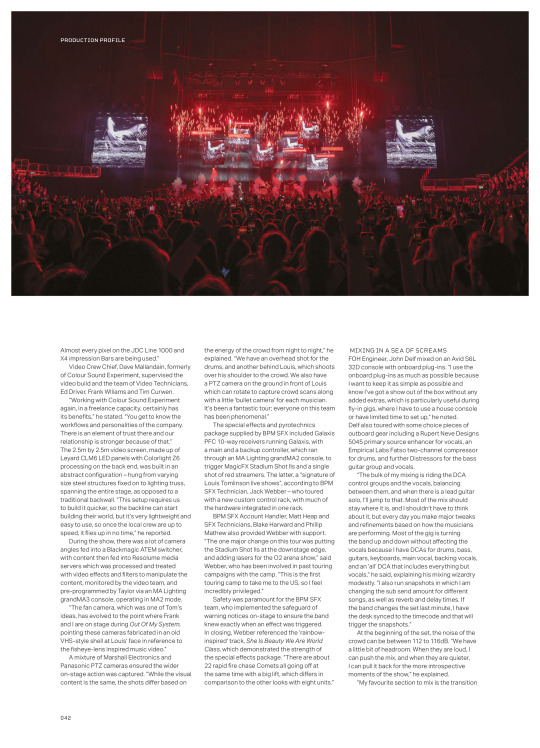
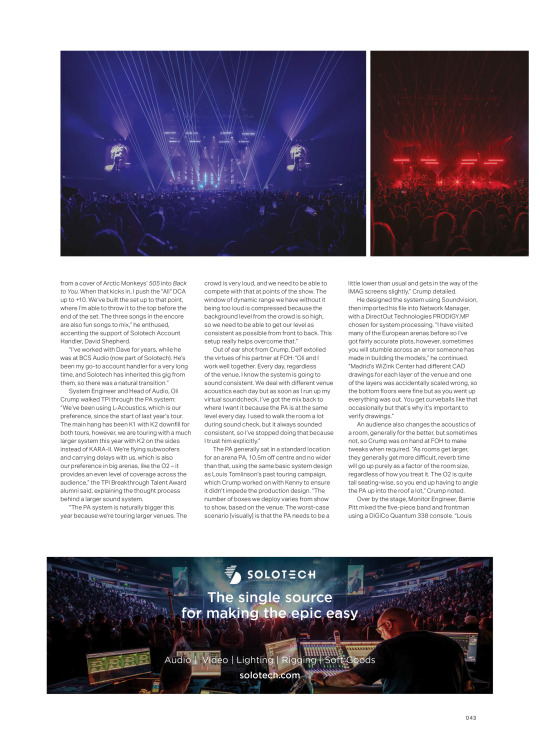
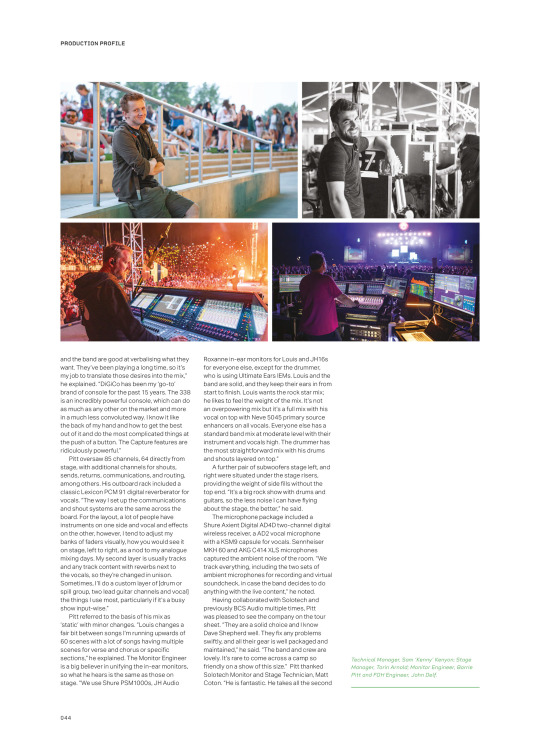

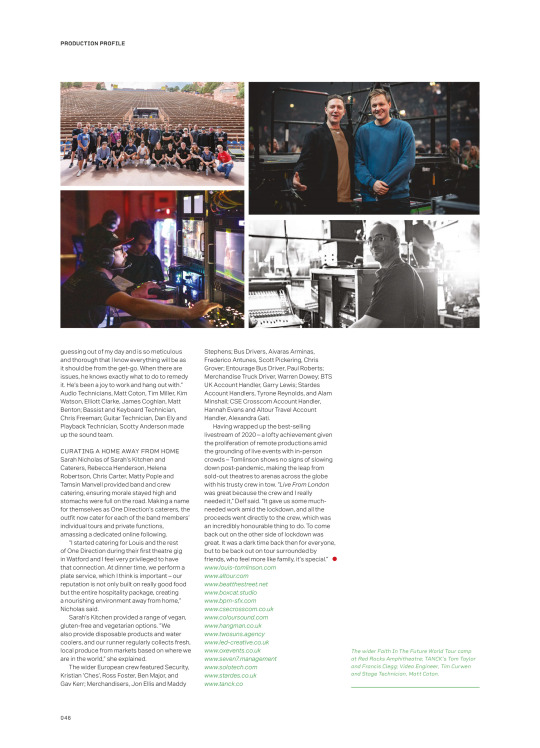
‘A dirty nightclub in an arena’ – behind Louis Tomlinson’s Faith In The Future World Tour
Louis Tomlinson and his tight-knit touring crew traverse the world in close to 80 shows, fulfilling a ‘dirty nightclub in an arena’ brief with a dynamic live campaign.
Production Profiles 5 January 2024
Following the success of his record-breaking Live From London livestream, which reportedly raised over £1m for touring and live events personnel and charitable organisations, Louis Tomlinson and his tight-knit crew have toured the world twice over. This time, visiting sold-out arenas in Europe and the UK with a cleverly networked live production with abstract video and lighting and a ‘no frills’ approach to sound, which guaranteed that every ticket holder experienced the same show, regardless of where they stood, sat, or screamed (more on that later). With close to 80 shows under their belt, TPi visited London’s O2 arena ahead of the production’s penultimate date of 2023.
Words: Jacob Waite Photos: Justin De Souza and Oli Crump
------
Following the success of his record-breaking Live From London livestream, which reportedly raised over £1m for touring and live events personnel and charitable organisations, Louis Tomlinson and his tight-knit crew have toured the world twice over. This time, visiting sold-out arenas in Europe and the UK with a cleverly networked live production with abstract video and lighting and a ‘no frills’ approach to sound, which guaranteed that every ticket holder experienced the same show, regardless of where they stood, sat, or screamed (more on that later). With close to 80 shows under their belt, TPi visited London’s O2 arena ahead of the production’s penultimate date of 2023.
“A team effort is required to get this show off the ground,” explained Technical Manager, Sam ‘Kenny’ Kenyon, who has been a fixture of Louis Tomlinson’s live output since joining as Lighting Crew Chief in 2019. “This has been a complete redesign, and the production has expanded and gotten more complex, which requires different solutions to make it happen.”
Kenny and the team oversaw the deployment of an A and B rig. “We’ve been fortunate for the European stint that the venues we’ve toured have, mostly, been arenas. The main difference between the A and B rig is the addition of IMAG and further lighting header trusses. Aside from that, the A rig fits everywhere. If anything, we’ve run into weight issues, which we can overcome swiftly by removing overhead trusses.”
For the first few shows, Riggers, Ian Bracewell, and Alex Walker incorporated load cells on trusses to get an accurate rate and account of the weight of the load of each truss. In the UK, The Brighton Centre had a particularly low-rate roof with weight limitations. Production Manager, Craig Sherwood and Tour Manager, Tom Allen’s vendors of choice included: Altour (travel), Beat the Street, BPM SFX, CSE Crosscom, Colour Sound Experiment (lighting, rigging, and video), Hangman UK, Boxcat Studio and Two Suns Creative (video content), LED Creative, Ox Event House (custom light housings), Sarah’s Kitchen, Seven 7 Management (artist management), Solotech (audio), Stardes Trucking, and TANCK (production design and video content).
There was no video director, as the show’s visuals were programmed and interspersed with live footage and triggered by a lighting console at FOH, thanks in part to an intricate network setup. “There’s a lot going on in racks that people never see, but it has been stable thanks to the quality of kit supplied by our vendors, who have invested heavily, and the team taking the time to programme the show,” Kenny noted.
Key to the success of the operation was the incorporation of Central Control software, which takes a signal from a lighting console, be it ACN or Art-Net, and translates it to talk to various products – in this case, video. “There is a giant brain that nobody knows exists other than those that have programmed it,” he added.
Additional crew members joined the tour in Europe to aid the video deployment and lead to far more efficient load-in an -outs. “We are close to 80 shows in and on days where we have access to multiple trucks, it comes out very quickly, which for a show of this scale is impressive and credit goes to the team,” enthused Kenny. “The biggest hurdle is when you’ve only got a two-truck dock.”
Prior to the tour, the team had five days of production rehearsals spent in Connecticut’s Mohegan Sun. “When we came to Europe a week later, we had a week of re-prepping with a day of rehearsals at Hamburg’s Barclays Arena, the day before a show,” he described. “It’s been a fun and long run,” added Stage Manager, Torin Arnold. “We’ve visited a good range of venues and countries – especially the Eastern European legs, visiting places you wouldn’t ordinarily tour and experiencing how they operate. This show is designed so it can be accomplished in any part of the world.” Carpenter, Harry Reeves was also on hand to support the build.
The routing, however, was sometimes challenging with some late arrivals and difficult border crossings. “There were a few times in Eastern Europe where we were doing a ferry back-to-back to arrive at 11am, sitting at a difficult border crossing. We usually start with a 7am mark out, so knocking hours off your load-in is tough but everyone pulled together to overcome it,” Arnold explained, noting that touring without staging, and instead, using venue stages (particularly rolling stages), was a blessing during those late arrivals. “As with any tour, as dates progress you build a rhythm while maintaining the safety of the build,” he noted.
Arnold also highlighted the benefit of Lead Truck Driver, Neil Thornton and Truck Drivers, Matt Marlow, Ben Woods, Sarah Goldsmith, Bob Miles, Alam Minshall, Franco DeRosa, and Ollie Thornton who “speed up the process” and maintained a level of consistency.
The transitions between support acts before Louis hit the stage was equally seamless, with ample downstage space for the singer-songwriter to traverse during his performance. “Having a clean frontline means we have space to get the bands on and off,” he added. “Our vendors have also provided everything from an audio package standpoint for support acts, which also speeds up the load-in and -out.”
Highlighting a ‘bucket list’ show at Hollywood Bowl, working closely with US union officials as a “fun” and “interesting” experience, Arnold reflected on the entire tour with crewmembers he now considers close friends. “This is a close team and I’ve made some great memories and stories. It’s been a fun year!”
A DIRTY NIGHTCLUB IN AN ARENA Production Designer, Programmer and Director, Tom Taylor, and Francis Clegg of TANCK have worked with Louis Tomlinson ever since he made the leap to solo artist. “The production design has evolved into an angular, grungy, asymmetrical setup, borne out of the ‘dirty nightclub in an arena setting’ creative brief I was given,” Taylor said, citing the creative influence of Matt Vines and Seven 7 Management. “Louis is a phenomenal performer, and the crowd is captivated the entire time. We started knocking ideas around, speaking to Louis about his inspirations and influences, which we then developed into a creative deck, which I sketched in Blender, and imported into WYSIWYG for visuals, to create stills and pre-visualise.”
Taylor spent 10 days programming the visuals at Colour Sound Experiment, a firm he shares a “longstanding” relationship with. “They are always a call away regardless of the day or time. Their team is easy to get along with and I like their whole ‘production sphere’ – sometimes it’s nice to split lighting and video, but for a show like this, aligning those departments with one line of communication is ideal,” he said, underlining the support of Colour Sound Experiment Account Handler, Haydn Cruickshank.
With production rehearsals under their belt and recordings from Louis Tomlinson World Tour (2020–22), where TANCK piloted Central Control software, the creatives understood how the singer and his band moved on stage, developing a rhythm and consistency of when to implement visual cues and which camera angle fit best. This allowed the team to pre-programme the visual content to timecode.
Video content was made by a combination of TANCK, Two Suns Creative, and Boxcat Studio, with the latter creating 3D models and rendered content, all of which was broadcast across a unique set of video surfaces. “Having the abstract video columns on stage makes it much more interesting than your standard slab of LED at the back of the stage,” Taylor noted.
On stage boxes created by Ox Event House housed GLP JDC Line 1000 strobes with reflective panelling and fabric that were printed to look like heavy concrete slabs, ladened with custom LED Creative solutions. These boxes then moved up and down using Wahlberg Motion Design winches to provide a “low-level, clubby feel” to the set.
“The winches can only carry 50kg and the lights alone are 35kg, so we had to be careful not to overload them, but the result was cool. We also have one single lightbulb on a winch which comes up and down above Louis to create a classic lighting moment,” Taylor said, further highlighting Ayrton Huracán’s prismatic colour wheel as a ‘fan favourite’.
The lighting design saw a wall of GLP impression X4 Bar 20s at the rear of the stage in 12 columns. Further lighting trusses over the stage carried the Wahlberg winches for several automated looks. The DMX winches were utilised for three or four songs, either statically or moving up and down, while JDC Line 1000s provided colour and strobe effects, to achieve varied looks, with a relatively minimal overhead lighting package.
Taylor elaborated: “There are some shutters for one specific track which go directly in-front of some of the GLP X4 Bars to get the aura of the lights, instead of the lenses, which I really like the look of. Lighting and video complement each other during this show – there’s also a section with flickering fluorescent tubes on the video content with the X4 Bar 20s behind the LED screens flickering in a similar way.
Taylor was delighted with the performance of the crew. “Overall, it has been a great run, executed flawlessly,” he commented, citing the support of Lighting Crew Chief, James Box; Dimmer Technician, Rick Carr, and Lighting Technicians, Amy Barnett, and Kieran Hancox.
The wider lighting rig comprised Ayrton Eurus, CHAUVET Professional Strike Array 4, Claypaky Mini-B eLumen8 Endura 1Q120, and Robe BMFL fixtures with robo cameras, all fixed on various HOF MLT3, Litec QH40 and Thomas James Thomas Engineering Superstruss. The lighting riser featured Ayrton Huracan LT and GLP JDC1 fixtures.
Robe Spiider fixtures were situated on the up and downstage video trusses, with the floor package boasting the deployment of further Ayrton Eurus, LEDJ Spectra Flood Q15 and Chroma-Q Color Force 72 units, the latter chosen for key light. Atmospherics came in the shape of Smoke Factory Tour Hazer 2, Martin Professional JEM ZR45 and MDG Atmosphere ATMe hazers with TMB ProFans. “We had some challenging shows, implementing an arena-scale design into sheds in the US, but it’s been good to return to Europe and witness the fans enjoying the show,” added Lighting Crew Chief, James Box, who pinpointed the use of the multicoloured glass gobo in Hurricanes as among his favourite looks.
“There is a lot of effort put in by TANCK to ensure we get the utmost from every fixture on the rig, which is great to see, when the team has gone to the effort of assembling the show each morning. Seeing the looks they achieve from the rig and the extra details, with each advanced cue within the show, is a pleasure.
Almost every pixel on the JDC Line 1000 and X4 impression Bars are being used.”
Video Crew Chief, Dave Mallandain, formerly of Colour Sound Experiment, supervised the video build and the team of Video Technicians, Ed Driver, Frank Wlliams and Tim Curwen.
“Working with Colour Sound Experiment again, in a freelance capacity, certainly has its benefits,” he stated. “You get to know the workflows and personalities of the company. There is an element of trust there and our relationship is stronger because of that.” The 2.5m by 2.5m video screen, made up of Leyard CLM6 LED panels with Colorlight Z6 processing on the back end, was built in an abstract configuration – hung from varying size steel structures fixed on to lighting truss, spanning the entire stage, as opposed to a traditional backwall. “This setup requires us to build it quicker, so the backline can start building their world, but it’s very lightweight and easy to use, so once the local crew are up to speed, it flies up in no time,” he reported.
During the show, there was a lot of camera angles fed into a Blackmagic ATEM switcher, with content then fed into Resolume media servers which was processed and treated with video effects and filters to manipulate the content, monitored by the video team, and pre-programmed by Taylor via an MA Lighting grandMA3 console, operating in MA2 mode.
“The fan camera, which was one of Tom’s ideas, has evolved to the point where Frank and I are on stage during Out Of My System, pointing these cameras fabricated in an old VHS-style shell at Louis’ face in reference to the fisheye-lens inspired music video.”
A mixture of Marshall Electronics and Panasonic PTZ cameras ensured the wider on-stage action was captured. “While the visual content is the same, the shots differ based on the energy of the crowd from night to night,” he explained. “We have an overhead shot for the drums, and another behind Louis, which shoots over his shoulder to the crowd. We also have a PTZ camera on the ground in front of Louis which can rotate to capture crowd scans along with a little ‘bullet camera’ for each musician. It’s been a fantastic tour; everyone on this team has been phenomenal.”
The special effects and pyrotechnics package supplied by BPM SFX included Galaxis PFC 10-way receivers running Galaxis, with a main and a backup controller, which ran through an MA Lighting grandMA2 console, to trigger MagicFX Stadium Shot IIs and a single shot of red streamers. The latter, a “signature of Louis Tomlinson live shows”, according to BPM SFX Technician, Jack Webber – who toured with a new custom control rack, with much of the hardware integrated in one rack.
BPM SFX Account Handler, Matt Heap and SFX Technicians, Blake Harward and Phillip Mathew also provided Webber with support. “The one major change on this tour was putting the Stadium Shot IIs at the downstage edge, and adding lasers for the O2 arena show,” said Webber, who has been involved in past touring campaigns with the camp. “This is the first touring camp to take me to the US, so I feel incredibly privileged.”
Safety was paramount for the BPM SFX team, who implemented the safeguard of warning notices on-stage to ensure the band knew exactly when an effect was triggered. In closing, Webber referenced the ‘rainbow-inspired’ track, She Is Beauty We Are World Class, which demonstrated the strength of the special effects package. “There are about 22 rapid fire chase Comets all going off at the same time with a big lift, which differs in comparison to the other looks with eight units.”
MIXING IN A SEA OF SCREAMS FOH Engineer, John Delf mixed on an Avid S6L 32D console with onboard plug-ins. “I use the onboard plug-ins as much as possible because I want to keep it as simple as possible and know I’ve got a show out of the box without any added extras, which is particularly useful during fly-in gigs, where I have to use a house console or have limited time to set up,” he noted. Delf also toured with some choice pieces of outboard gear including a Rupert Neve Designs 5045 primary source enhancer for vocals, an Empirical Labs Fatso two-channel compressor for drums, and further Distressors for the bass guitar group and vocals.
“The bulk of my mixing is riding the DCA control groups and the vocals, balancing between them, and when there is a lead guitar solo, I’ll jump to that. Most of the mix should stay where it is, and I shouldn’t have to think about it, but every day you make major tweaks and refinements based on how the musicians are performing. Most of the gig is turning the band up and down without affecting the vocals because I have DCAs for drums, bass, guitars, keyboards, main vocal, backing vocals, and an ‘all’ DCA that includes everything but vocals,” he said, explaining his mixing wizardry modestly. “I also run snapshots in which I am changing the sub send amount for different songs, as well as reverb and delay times. If the band changes the set last minute, I have the desk synced to the timecode and that will trigger the snapshots.”
At the beginning of the set, the noise of the crowd can be between 112 to 116dB. “We have a little bit of headroom. When they are loud, I can push the mix, and when they are quieter, I can pull it back for the more introspective moments of the show,” he explained.
“My favourite section to mix is the transition from a cover of Arctic Monkeys’ 505 into Back to You. When that kicks in, I push the “All” DCA up to +10. We’ve built the set up to that point, where I’m able to throw it to the top before the end of the set. The three songs in the encore are also fun songs to mix,” he enthused, accenting the support of Solotech Account Handler, David Shepherd.
“I’ve worked with Dave for years, while he was at BCS Audio (now part of Solotech). He’s been my go-to account handler for a very long time, and Solotech has inherited this gig from them, so there was a natural transition.”
System Engineer and Head of Audio, Oli Crump walked TPi through the PA system: “We’ve been using L-Acoustics, which is our preference, since the start of last year’s tour. The main hang has been K1 with K2 downfill for both tours, however, we are touring with a much larger system this year with K2 on the sides instead of KARA-II. We’re flying subwoofers and carrying delays with us, which is also our preference in big arenas, like the O2 – it provides an even level of coverage across the audience,” the TPi Breakthrough Talent Award alumni said, explaining the thought process behind a larger sound system.
“The PA system is naturally bigger this year because we’re touring larger venues. The crowd is very loud, and we need to be able to compete with that at points of the show. The window of dynamic range we have without it being too loud is compressed because the background level from the crowd is so high, so we need to be able to get our level as consistent as possible from front to back. This setup really helps overcome that.”
Out of ear shot from Crump, Delf extolled the virtues of his partner at FOH: “Oli and I work well together. Every day, regardless of the venue, I know the system is going to sound consistent. We deal with different venue acoustics each day but as soon as I run up my virtual soundcheck, I’ve got the mix back to where I want it because the PA is at the same level every day. I used to walk the room a lot during sound check, but it always sounded consistent, so I’ve stopped doing that because I trust him explicitly.”
The PA generally sat in a standard location for an arena PA, 10.5m off centre and no wider than that, using the same basic system design as Louis Tomlinson’s past touring campaign, which Crump worked on with Kenny to ensure it didn’t impede the production design. “The number of boxes we deploy varies from show to show, based on the venue. The worst-case scenario [visually] is that the PA needs to be a little lower than usual and gets in the way of the IMAG screens slightly,” Crump detailed.
He designed the system using Soundvision, then imported his file into Network Manager, with a DirectOut Technologies PRODIGY.MP chosen for system processing. “I have visited many of the European arenas before so I’ve got fairly accurate plots, however, sometimes you will stumble across an error someone has made in building the models,” he continued. “Madrid’s WiZink Center had different CAD drawings for each layer of the venue and one of the layers was accidentally scaled wrong, so the bottom floors were fine but as you went up everything was out. You get curveballs like that occasionally but that’s why it’s important to verify drawings.”
An audience also changes the acoustics of a room, generally for the better, but sometimes not, so Crump was on hand at FOH to make tweaks when required. “As rooms get larger, they generally get more difficult, reverb time will go up purely as a factor of the room size, regardless of how you treat it. The O2 is quite tall seating-wise, so you end up having to angle the PA up into the roof a lot,” Crump noted.
Over by the stage, Monitor Engineer, Barrie Pitt mixed the five-piece band and frontman using a DiGiCo Quantum 338 console. “Louis and the band are good at verbalising what they want. They’ve been playing a long time, so it’s my job to translate those desires into the mix,” he explained. “DiGiCo has been my ‘go-to’ brand of console for the past 15 years. The 338 is an incredibly powerful console, which can do as much as any other on the market and more in a much less convoluted way. I know it like the back of my hand and how to get the best out of it and do the most complicated things at the push of a button. The Capture features are ridiculously powerful.”
Pitt oversaw 85 channels, 64 directly from stage, with additional channels for shouts, sends, returns, communications, and routing, among others. His outboard rack included a classic Lexicon PCM 91 digital reverberator for vocals. “The way I set up the communications and shout systems are the same across the board. For the layout, a lot of people have instruments on one side and vocal and effects on the other, however, I tend to adjust my banks of faders visually, how you would see it on stage, left to right, as a nod to my analogue mixing days. My second layer is usually tracks and any track content with reverbs next to the vocals, so they’re changed in unison. Sometimes, I’ll do a custom layer of [drum or spill group, two lead guitar channels and vocal] the things I use most, particularly if it’s a busy show input-wise.”
Pitt referred to the basis of his mix as ‘static’ with minor changes. “Louis changes a fair bit between songs I’m running upwards of 60 scenes with a lot of songs having multiple scenes for verse and chorus or specific sections,” he explained. The Monitor Engineer is a big believer in unifying the in-ear monitors, so what he hears is the same as those on stage. “We use Shure PSM1000s, JH Audio Roxanne in-ear monitors for Louis and JH16s for everyone else, except for the drummer, who is using Ultimate Ears IEMs. Louis and the band are solid, and they keep their ears in from start to finish. Louis wants the rock star mix; he likes to feel the weight of the mix. It’s not an overpowering mix but it’s a full mix with his vocal on top with Neve 5045 primary source enhancers on all vocals. Everyone else has a standard band mix at moderate level with their instrument and vocals high. The drummer has the most straightforward mix with his drums and shouts layered on top.”
A further pair of subwoofers stage left, and right were situated under the stage risers, providing the weight of side fills without the top end. “It’s a big rock show with drums and guitars, so the less noise I can have flying about the stage, the better,” he said.
The microphone package included a Shure Axient Digital AD4D two-channel digital wireless receiver, a AD2 vocal microphone with a KSM9 capsule for vocals. Sennheiser MKH 60 and AKG C414 XLS microphones captured the ambient noise of the room. “We track everything, including the two sets of ambient microphones for recording and virtual soundcheck, in case the band decides to do anything with the live content,” he noted.
Having collaborated with Solotech and previously BCS Audio multiple times, Pitt was pleased to see the company on the tour sheet. “They are a solid choice and I know Dave Shepherd well. They fix any problems swiftly, and all their gear is well packaged and maintained,” he said. “The band and crew are lovely. It’s rare to come across a camp so friendly on a show of this size.” Pitt thanked Solotech Monitor and Stage Technician, Matt Coton. “He is fantastic. He takes all the second guessing out of my day and is so meticulous and thorough that I know everything will be as it should be from the get-go. When there are issues, he knows exactly what to do to remedy it. He’s been a joy to work and hang out with.”
Audio Technicians, Matt Coton, Tim Miller, Kim Watson, Elliott Clarke, James Coghlan, Matt Benton; Bassist and Keyboard Technician, Chris Freeman; Guitar Technician, Dan Ely and Playback Technician, Scotty Anderson made up the sound team.
CURATING A HOME AWAY FROM HOME Sarah Nicholas of Sarah’s Kitchen and Caterers, Rebecca Henderson, Helena Robertson, Chris Carter, Matty Pople and Tamsin Manvell provided band and crew catering, ensuring morale stayed high and stomachs were full on the road. Making a name for themselves as One Direction’s caterers, the outfit now cater for each of the band members’ individual tours and private functions, amassing a dedicated online following. “I started catering for Louis and the rest of One Direction during their first theatre gig in Watford and I feel very privileged to have that connection. At dinner time, we perform a plate service, which I think is important – our reputation is not only built on really good food but the entire hospitality package, creating a nourishing environment away from home,” Nicholas said.
Sarah’s Kitchen provided a range of vegan, gluten-free and vegetarian options. “We also provide disposable products and water coolers, and our runner regularly collects fresh, local produce from markets based on where we are in the world,” she explained.
The wider European crew featured Security, Kristian ‘Ches’, Ross Foster, Ben Major, and Gav Kerr; Merchandisers, Jon Ellis and Maddy Stephens; Bus Drivers, Aivaras Arminas, Frederico Antunes, Scott Pickering, Chris Grover; Entourage Bus Driver, Paul Roberts; Merchandise Truck Driver, Warren Dowey; BTS UK Account Handler, Garry Lewis; Stardes Account Handlers, Tyrone Reynolds, and Alam Minshall; CSE Crosscom Account Handler, Hannah Evans and Altour Travel Account Handler, Alexandra Gati.
Having wrapped up the best-selling livestream of 2020 – a lofty achievement given the proliferation of remote productions amid the grounding of live events with in-person crowds – Tomlinson shows no signs of slowing down post-pandemic, making the leap from sold-out theatres to arenas across the globe with his trusty crew in tow. “Live From London was great because the crew and I really needed it,” Delf said. “It gave us some much-needed work amid the lockdown, and all the proceeds went directly to the crew, which was an incredibly honourable thing to do. To come back out on the other side of lockdown was great. It was a dark time back then for everyone, but to be back out on tour surrounded by friends, who feel more like family, it’s special.”
-> read here on Issuu
#louis#fitf tour#fitfwt#lt crew#tpi magazine#05.01.24#article#touring#thank youu omglarryrabbit ;)#love getting to peek behind the scenes this is great
101 notes
·
View notes
Text
🤖 AI Influencer 24/7 Review: Launch Your Own Virtual Superstar That Sells, Engages & Grows Your Brand — All On Autopilot! 💸🌍📲

What if you could launch a fully-branded AI influencer that creates content, talks to your audience, and promotes your offers — on every platform, in any language, with zero effort on your part?
Well, now you can.
Introducing the AI Influencer 24/7 System — a powerful, one-click solution that lets you build and deploy your very own digital influencer that works around the clock, creating viral posts, talking like a human, and even selling products for you.
CLICK HERE TO GET INSTANT ACCESS NOW >>
🛠️ Key Features:
✅ One-Click AI Influencer Deployment 🧠 Launch your influencer in minutes — with custom branding, niche focus, and voice options.
✅ Omni-Platform Content Posting 📱 Your AI influencer will automatically create and post content to TikTok, YouTube Shorts, Reels, Twitter, and more.
✅ Real-Time Audience Engagement 💬 AI-powered chat interaction mimics real conversations, helping you engage, build trust, and convert followers.
✅ Multilingual Support 🌐 Reach a global audience by creating and responding in any language — automatically.
✅ Daily Content Creation & Promotion 🗓️ Your influencer will generate daily content AND promote affiliate offers, services, or your own products.
✅ Fully Branded with Your Voice or Persona 🧑🎤 Customize look, tone, and messaging to match your brand — or create a whole new personality.
✅ No Video/Design/Marketing Skills Needed 🙌 Perfect for beginners. All the tech and creative work is handled for you.
✅ Agency Mode 💼 Create and manage multiple AI influencers for clients — a done-for-you social media service without hiring talent.
💸 Real Results:
Users are seeing $200–$300+/day from affiliate sales, product promos, and client packages — all powered by their AI influencers doing the heavy lifting 24/7.
CLICK HERE TO GET INSTANT ACCESS NOW >>
✅ Pros:
100% beginner-friendly
Works on autopilot, even while you sleep
No need to show your face or be on camera
Monetize in multiple niches (fitness, finance, fashion, crypto, etc.)
Agencies can charge monthly for influencer campaigns
Great for affiliate marketing, ecommerce, personal brands
❌ Cons:
Needs proper setup and niche targeting to perform best
Some platforms may require manual approval for bots
AI engagement, while good, might not always pass as human in complex conversations
CLICK HERE TO GET INSTANT ACCESS NOW >>
💵 Pricing & OTOs (One-Time Offers):
Front-End App: $37 One-Time
OTO 1 – Pro Edition: $67 (Unlock advanced AI personalities & more content slots)
OTO 2 – Agency License: $97 (Manage for clients, add branding & team features)
OTO 3 – DFY Influencer Templates: $47 (Get plug-n-play niches ready to launch)
OTO 4 – Reseller Rights: $197 (Sell the software as your own)
🎁 Exclusive Bonuses (When You Grab It Today):
🎁 Viral Hooks & CTA Swipe File 🎁 100 Influencer Video Prompts for Any Niche 🎁 Step-by-Step AI Influencer Monetization Blueprint 🎁 Bonus Training: $1K/Week with AI Personal Brands
CLICK HERE TO GET INSTANT ACCESS NOW >>
🎯 Who Is This For?
Affiliate marketers
Freelancers & agencies
Ecommerce store owners
Social media beginners
Coaches, consultants & solopreneurs
Anyone who wants influencer-style results without being on camera
🔥 Final Verdict:
This AI Influencer 24/7 System is a total game-changer. Whether you're camera-shy, time-strapped, or just looking to automate your content game, this tool delivers massive value. With zero tech hassle, full branding control, and monetization built in, it's like hiring a full-time content creator, marketer, and spokesperson — all in one.
If you want to sell more, grow faster, and do it all on autopilot... 👉 This is the tool to watch.
CLICK HERE TO GET INSTANT ACCESS NOW >>
#marketing#affiliatemarketing#onlinemarketing#review#reviews#software#preview#digitalmarketing#usa#AIInfluencer#ContentAutomation#PassiveIncome#DigitalMarketing#OneClickSuccess
6 notes
·
View notes
Text
SQL Server 2022 Edition and License instructions
SQL Server 2022 Editions:
• Enterprise Edition is ideal for applications requiring mission critical in-memory performance, security, and high availability
• Standard Edition delivers fully featured database capabilities for mid-tier applications and data marts
SQL Server 2022 is also available in free Developer and Express editions. Web Edition is offered in the Services Provider License Agreement (SPLA) program only.
And the Online Store Keyingo Provides the SQL Server 2017/2019/2022 Standard Edition.
SQL Server 2022 licensing models
SQL Server 2022 offers customers a variety of licensing options aligned with how customers typically purchase specific workloads. There are two main licensing models that apply to SQL Server: PER CORE: Gives customers a more precise measure of computing power and a more consistent licensing metric, regardless of whether solutions are deployed on physical servers on-premises, or in virtual or cloud environments.
• Core based licensing is appropriate when customers are unable to count users/devices, have Internet/Extranet workloads or systems that integrate with external facing workloads.
• Under the Per Core model, customers license either by physical server (based on the full physical core count) or by virtual machine (based on virtual cores allocated), as further explained below.
SERVER + CAL: Provides the option to license users and/or devices, with low-cost access to incremental SQL Server deployments.
• Each server running SQL Server software requires a server license.
• Each user and/or device accessing a licensed SQL Server requires a SQL Server CAL that is the same version or newer – for example, to access a SQL Server 2019 Standard Edition server, a user would need a SQL Server 2019 or 2022 CAL.
Each SQL Server CAL allows access to multiple licensed SQL Servers, including Standard Edition and legacy Business Intelligence and Enterprise Edition Servers.SQL Server 2022 Editions availability by licensing model:
Physical core licensing – Enterprise Edition
• Customers can deploy an unlimited number of VMs or containers on the server and utilize the full capacity of the licensed hardware, by fully licensing the server (or server farm) with Enterprise Edition core subscription licenses or licenses with SA coverage based on the total number of physical cores on the servers.
• Subscription licenses or SA provide(s) the option to run an unlimited number of virtual machines or containers to handle dynamic workloads and fully utilize the hardware’s computing power.
Virtual core licensing – Standard/Enterprise Edition
When licensing by virtual core on a virtual OSE with subscription licenses or SA coverage on all virtual cores (including hyperthreaded cores) on the virtual OSE, customers may run any number of containers in that virtual OSE. This benefit applies both to Standard and Enterprise Edition.
Licensing for non-production use
SQL Server 2022 Developer Edition provides a fully featured version of SQL Server software—including all the features and capabilities of Enterprise Edition—licensed for development, test and demonstration purposes only. Customers may install and run the SQL Server Developer Edition software on any number of devices. This is significant because it allows customers to run the software on multiple devices (for testing purposes, for example) without having to license each non-production server system for SQL Server.
A production environment is defined as an environment that is accessed by end-users of an application (such as an Internet website) and that is used for more than gathering feedback or acceptance testing of that application.
SQL Server 2022 Developer Edition is a free product !
#SQL Server 2022 Editions#SQL Server 2022 Standard license#SQL Server 2019 Standard License#SQL Server 2017 Standard Liense
7 notes
·
View notes